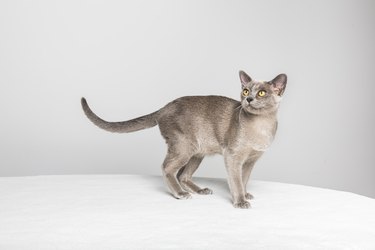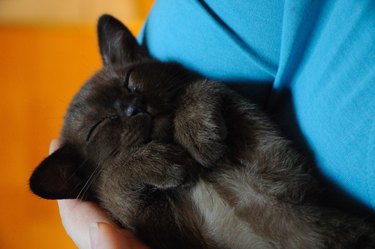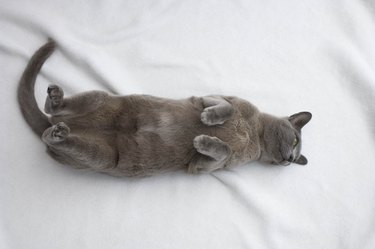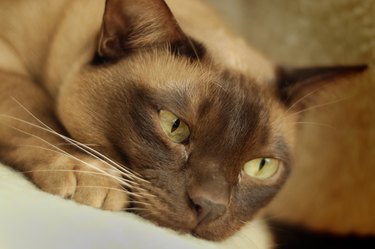
European Burmese cat quick facts
Length: 12 - 16 inches
Weight: Females: 7 - 10 pounds, Males: 10 - 14 pounds
Video of the Day
Video of the Day
Lifespan: 10 - 15 years
Coat length: Short
Coloring: Blue, brown, chocolate, cream, lilac, apricot red, and tortoiseshell with amber or yellow-gold eye color
Grooming needs: Low
Friendliness: Breed alone is not an accurate predictor of individual cats' personalities. However, European Burmese cats are generally regarded as loyal, affectionate, and intelligent.
The European Burmese cat shares many similarities with the Burmese cat breed. In fact, many cat registries, including the International Cat Association (TICA) and the Governing Council of the Cat Fancy (GCCF), do not consider them to be different breeds. There are many similarities between the two breeds and if you are looking for a loving, social, and affectionate cat to join your family, the European Burmese may be a good choice.

European Burmese cat history
The Burmese cat breed originated near the border of Thailand and Burma. In 1930, a chocolate Burmese cat named Wong Mau was brought to the United States and given to Dr. Joseph Thompson. Many people believed that Wong Mau was a Siamese cat, but Dr. Thompson believed she was a different breed. He started a breeding program and bred Wong Mau with a seal point Siamese cat.
The resulting litter had both solid and pointed kittens. The solid dark brown kittens were used to continue developing the Burmese breed. Some Burmese cats were brought to the United Kingdom where breeders continued developing the breed by outcrossing Burmese cats with Siamese cats. These cats became the European Burmese cat breed that was then recognized by the Cat Fanciers' Association (CFA).
One of the differences between the European and American Burmese breeds is the accepted coat colors. The CFA's breed standard for the Burmese cat only allows four colors: blue, champaign, platinum, and sable. The European Burmese breed standard allows for a greater variety of colors. Recognized colors include:
- blue
- brown
- chocolate
- lilac
- red
- cream
- brown-tortie
- chocolate-tortie
- blue-tortie
- lilac-tortie
There are other physical differences recognized in the breed standard as well. The European Burmese tends to have a more gently rounded and elegant build compared to the American Burmese cat's rounded and compact body shape. European Burmese cat's eyes are not as rounded as the American Burmese cat and the top line of the eye slants towards the cat's nose.
European Burmese cat personality
European Burmese cats are very social and have wonderful personalities. They enjoy your company and will gladly snuggle and embrace the joy of being a lap cat when you are relaxing at the end of the day. If you have multiple members in the household, your European Burmese may pick a favorite, but they will interact with the whole family.
The cats are not couch potatoes, though, and will gladly take part in any activities around the home. Even adult cats remain quite playful.
If you live alone and work long hours, this may not be the best breed for you as these cats prefer to have company. The cats do tend to get along well with other cats and dogs who can keep your cat company.

European Burmese cat lifespan and health issues
A healthy European Burmese cat can live to be 16 years or older. The breed tends to be healthy, but there are some health problems that may affect some cats including:
- hypokalemia, or low blood potassium
- diabetes mellitus
- eye problems such as glaucoma
- hypertrophic cardiomyopathy, which is a heart disease that causes the wall of the heart to thicken
In rare cases, Burmese cats may suffer from a neurological condition called feline orofacial pain syndrome. Cats will lick and paw at their face in response to the perceived pain although there is no real injury.
Responsible breeders will test for genetic health conditions when testing is available and stop breeding any cat that is affected by or a carrier of a genetic health condition. Be sure to discuss the health of the breeding cats and kittens before purchasing a purebred European Burmese kitten.
European Burmese cat grooming and care
The European Burmese is a shorthair cat that is very easy to groom. You can keep their short coat healthy and manage shedding by brushing the cat weekly with a rubber brush. These cats don't need to be bathed, but keep up with other pet care tasks including trimming their nails and brushing their teeth with a toothpaste that is veterinarian-approved for cats.
Feed your cat high-quality commercial cat food as recommended by your veterinarian and make sure they have access to fresh water at all times. The European Burmese should be kept as an indoor cat, so it is important to provide a scratching post so that they can honor their scratching instincts without harming your furniture and rugs.
Make sure to have daily play sessions with your cat. This ensures your cat gets the physical exercise and mental stimulation they need to stay healthy and happy. Take your cat to the veterinarian for regular check-ups and make sure they receive any recommended vaccinations

Welcoming a new cat into your home
Before you welcome your new European Burmese kitten into your home, take the time to cat-proof the house to make sure it is safe for your new feline companion. This includes removing any toxic plants and securing toxic foods and cleaning supplies in a place where the cat can't reach them. Don't forget to check the higher shelves and the tops of any bookshelves and the refrigerator. While your kitten may initially stay close to the ground, they grow quickly and will soon be jumping and climbing.
Set up a safe room where you can introduce the cat to the new home. Make sure it has everything your kitten or cat may need including:
- food and water
- litter box
- cat tree
- scratching post
- toys
When your cat arrives, allow them to explore the space at their own pace. Spend plenty of time with your new cat, but avoid the temptation to force them to be held or petted. Offer plenty of positive reinforcement and your patience will soon pay off as you develop a loving and trusting relationship.